Last week I was invited to speak to the Association of Independent Retirees, Northern Tasmania Branch, on 'Eating for Health'. I truly believe this is an important message at any age.
As Gary says, we plan for our Financial Retirement but often overlook our Health Retirement.
I would like to thank Christina Holmdahl, West Tamar Mayor for inviting me to speak at Windsor Community Centre last Friday and to the president of the AIR Northern Tasmania branch, Shane Dennington, for the warm welcome I received.
I presented a short overview of Eating for Health and Low Carb Healthy Fat principles. I talked about how much sugar is in foods we often consider to be 'healthy'. I touched on fats and cholesterol, did some label reading and had plenty of time for some questions at the end. I also printed the Starter Guide from my website page What is Low Carb Healthy Fat? for attendees.
Health is defined as a state of complete physical, mental and social well-being, not merely the absence of disease.
The World Health Organisation defines Health as a state of complete physical, mental and social well-being, not merely the absence of disease. It is also important to consider that health can mean different things to different people...
Planning for your Health Retirement

Planning for retirement is one of Gary’s pet topics… Since we began working in our 20’s we have contributed to our financial retirement, putting money into superannuation and investing where we can. Financially we are compounding the interest and hopefully creating a nice little nest egg… Unfortunately, it is only in the last few years we have considered our 'health retirement'. We suddenly realised it was quickly becoming a compounding debt!
Retirement is about much more than ‘what’s in the bank’ though money matters, of course.
Health and Wellbeing in retirement is about adopting a healthy lifestyle, making it sustainable for you, and then sticking to it for as long as you can. Without health, you may have trouble enjoying the wealth you have tucked away.
Medical Tourism

You don’t want to find yourself becoming a medical tourist in your retirement - going from one medical appointment to the next. Unfortunately, Gary sees many people caught up in this scenario. With so much misinformation about diet and health, and without the tools to take back control of your own health, it is completely understandable.
Gary was heading down this road, himself. At 38 he had cancer, he was overweight, pre-diabetic, high blood pressure and episodes of cardiac arrhythmia’s. He was at the peak of his medical career, madly band-aiding sick-care, with little thought for his own health ... there was no time to think about that!

15 years ago Gary was on a cocktail of medications, some simply to counteract the side effects of other medications he was taking. He never gave a thought to his diet.
As far as he was concerned he was eating 'healthy' - plenty of grains, bread, pasta, fruits, vegetables, lean meats and 'processed' margarine. Low fat milk, cheeses and yoghurt lived permanently in our fridge. Gary loved juice and downed a glass each morning for breakfast and he snacked on chocolate, too.
It wasn’t until Gary read David Gillespie’s book Sweet Poison in 2011 that he started to tie sugar into his health equation and a few more weeks down the track that he suddenly remembered that Carbohydrates turn into Glucose the minute you ingest them.
Biochemistry 101!!!
So, the Australian Dietary Guideline recommendations of 6 – 11 servings of Carbohydrates back in 1992, probably weren’t such a great idea! Especially as it appears that the Australian Dietary Guidelines (ADG's) have been shaped by Vested Interests and Ideology for 150 years.
The Australian Dietary Guidelines push processed food
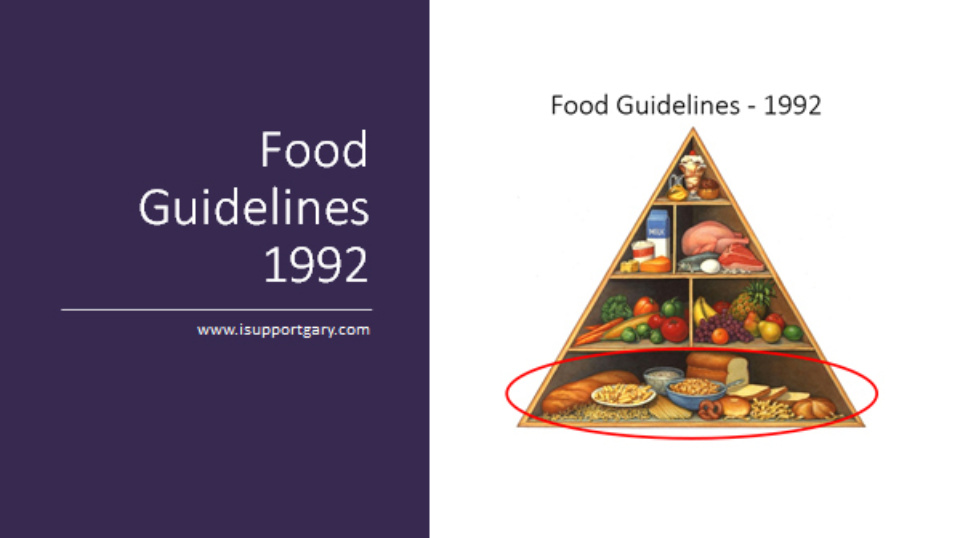
This is the food pyramid that influenced Gary as a young doctor, and no doubt many households in Australia, for the next 3 decades.
I have been researching for years to try to understand why Gary was reported, investigated for 2 ½ years and ‘Silenced’ by the AHPRA Medical Board of Tasmania despite providing a thesis worth of research to back up his recommendations of Low Carbohydrate Healthy Fat principles to his patients and the broader community… Seems the Food Industry wants us to eat a Plant-Based wholegrain, low fat diet because then they can formulate all our processed food.
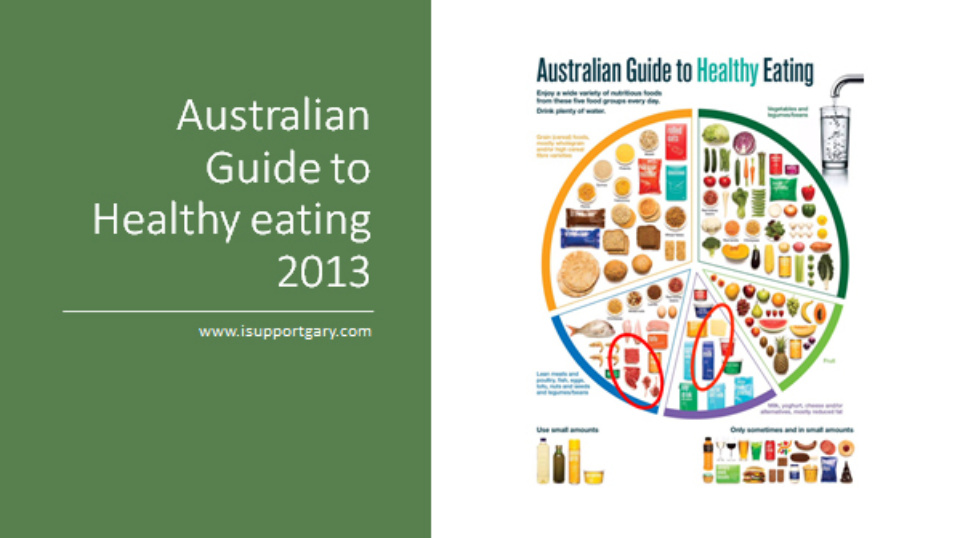
Gary created this slide for his talk in America last year, to point out that we need to send out a 'search and rescue party' to find the red meat and dairy in the 2013 Australia Guide to Healthy Eating!
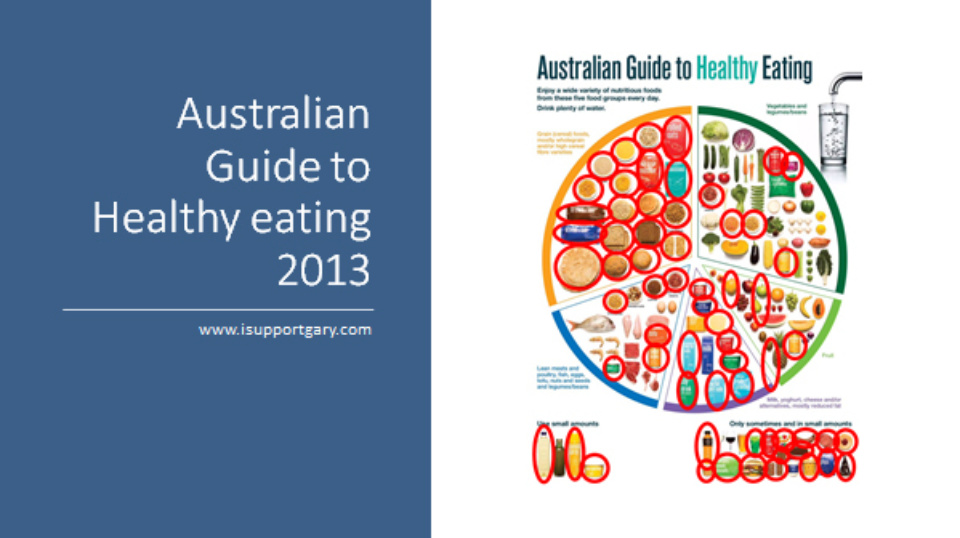
But, no problems at all finding processed foods shot-gunned all over the place …
Busting Medical and Nutrition Myths
*Firstly, the brain does not require 130 grams of INGESTED glucose to function.
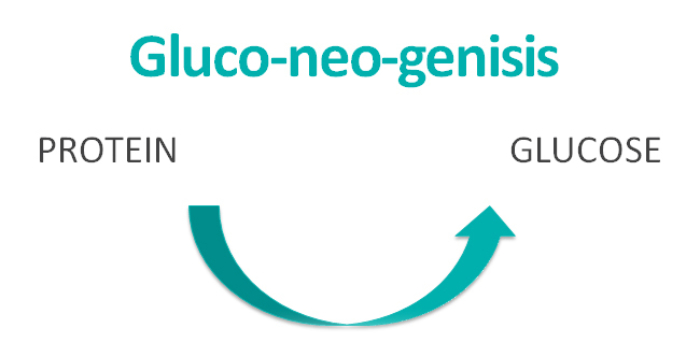
Our body can turn protein into glucose via conversion in the liver called gluco-neo-genisis. We can also use fat to make ketone bodies to use for fuel. Eskimos tended to use this fuelling before the advent of remote transportation because they couldn’t access fruit or carbohydrate vegetables and they certainly didn’t have supermarkets up in the arctic. Not only did they survive, but they thrived ;-)
I know of many people who eat less than 120g of carbohydrates each day. Gary would typically eat 50 grams or less of carbohydrate because his particular form of cancer feeds on sugar (and glucose sugar) and being in a state of nutritional ketosis is keeping him in remission.
Nutritional ketosis is VERY different to Ketoacidosis that may be life threatening to people with diabetes.
*Cholesterol clogs arteries
The "Cholesterol clogs arteries" thinking came about in the 1970’s and was adopted by the US McGovern Report that led to dietary guidelines around the world advocating low fat for heart health.
Saturated fat blocked drains so it must block arteries? Right??? Wrong … Saturated fat congeals at room temperature in Tasmania, but not in the tropics! Just like coconut oil… butter, lard and bacon fat solidifies in our kitchen pots and pans, in the fridge and yes, in our drains, but our body temperature is 36-37 degrees. Saturated fat does NOT congeal or solidify at that temperature.
Gary explains the science much better than I can, but he assures me that sugar and processed carbohydrates cause plaques to grow in our blood vessels and the cholesterol is there to mop them up. It is like blaming firemen for a fire simply because they are at the scene trying to put it out!!
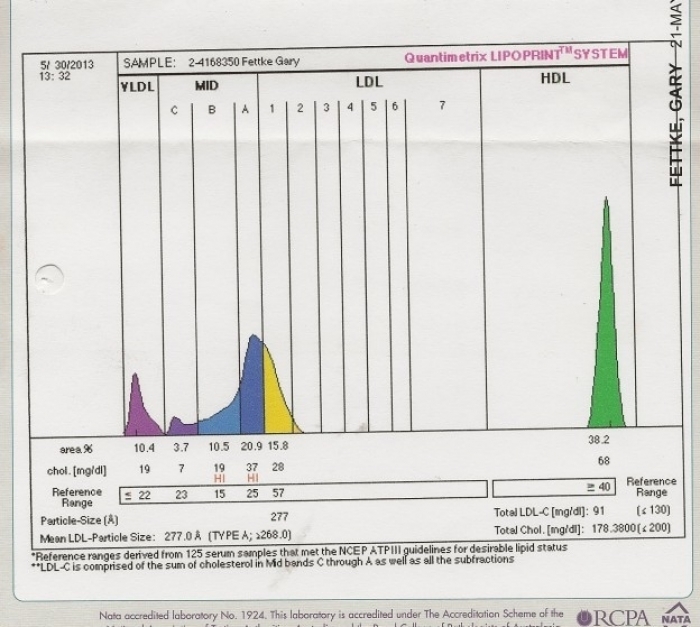
I highly suggest you take a look
at Dave Feldman’s work on cholesterol if you are interested. He is able to make
his cholesterol levels adjust to the Dow Jones! Gary also recommends a Lipid Subfraction
analysis to tease out cholesterol markers if needed. This is Gary’s results after 4 years
of eating Low Carbohydrate Healthy Fat principles #LCHF and there are NO ‘bad’ small dense LDL particles.
*Type 2 Diabetes is a chronic progressive disease
After Gary’s health began improving from reducing sugar and processed carbohydrates from his diet, he started to consider how it may also help his patients with weight-related joint issues and the complications of Type 2 diabetes. 25 years ago Gary saw a couple of people a year who required partial or full amputations for the complications of diabetes. Unfortunately, in the last few of years, he regularly sees a patient a week with foot infections requiring hospitalisation for debriding, and far too often …amputation of parts of feet and lower limbs.
Gary started recommending that his patients consider reducing sugar in 2013 and created a simple handout like the one I will share with you today. In late 2014 he began recommending adopting Low Carbohydrate Healthy Fat principles to improve blood glucose levels and found many improved their health outcomes, often reducing the need for surgery. He realised that Type 2 diabetes does not have to be a chronic progressive disease …
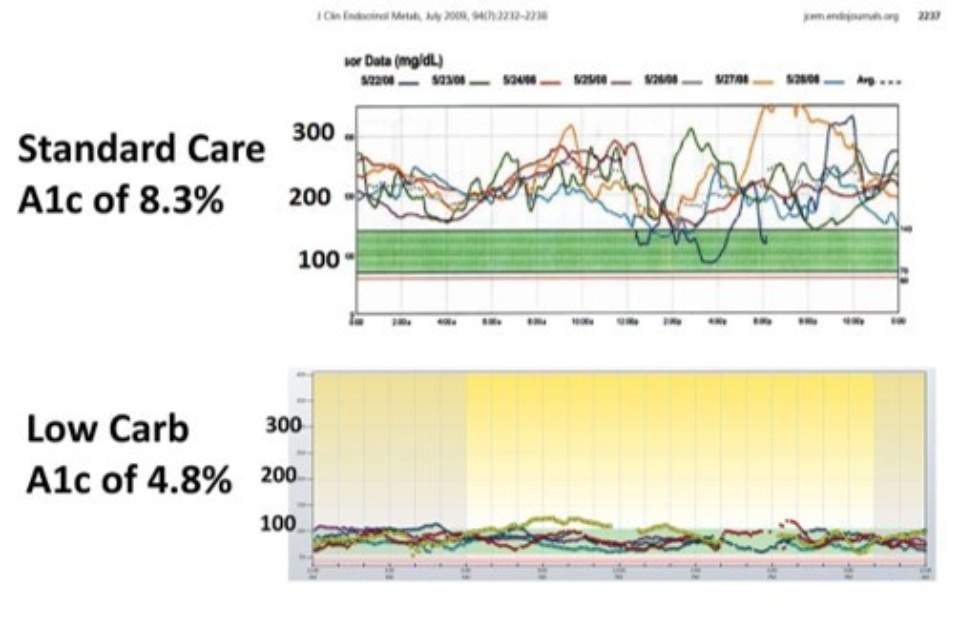
According to Diabetes Australia 280 Australians develop Type 2 diabetes every day. That’s one person every five minutes. The total annual cost impact of diabetes is Australia was estimated at $14.6 billion.
Unfortunately, people with Type 2 diabetes aren’t always getting the right information.
- Many are unaware that carbohydrates end up as glucose in the blood stream and high amounts cause a rise in blood glucose levels, regardless of whether they are low Glycaemic Index or not.
- They aren’t always being told that low fat products often have a significant amount of added sugar to improve palatability.
- They aren’t always being told that insulin is a fat storing hormone and a side-effect of excess insulin is weight gain.
- They aren’t always being told that weight gain causes insulin resistance which will mean they will require even more insulin!
- And, they aren’t being told that there is another approach to managing their disease. Normal Blood Glucose levels can be achieved by simply reducing sugar and processed carbohydrates from the diet.
LCHF and improved Health Outcomes
“Your advice to me was to lose weight and take the pressure off my knees and possibly forestall the need for a knee replacement by years.” So I did.
LCHF isn’t just for people with diabetes. It can help lots of people take back control of their health. Michael wrote to thank Gary for his advice … “Quite frankly, this time last year I was in trouble, I had a job to stand up from sitting in a chair, or get out of the car.

I didn’t want to risk walking in the bush with my dogs for fear of tripping over the smallest branch.” Michael went on to say that Gary’s advice to lose weight and take the pressure off his knees to possibly forestall a knee replacement by years, worked well. Outcomes like this bring joy to medicine. Making sustainable changes to your diet and lifestyle isn’t always easy. Some people have no problems at all losing weight and improving their health, for others the journey may take more time. Having support, motivation and accountability can really help. As Gary says “once you see the health benefits of LCHF you can never unsee them”.
Eating for Health - Low Carbohydrate Healthy Fat principles

So, what is healthy eating?
We believe healthy eating is going back to fresh, seasonal and locally produced food as much as possible. We are lucky in Tasmania to be able to access ethically raised, pasture fed produce; eggs, meats, cheeses and lots of locally grown vegetables, nuts, olive oils and fruit. This produce just so happens to be Lower in Carbohydrates, have no added sugars and be healthy saturated fats.
Unfortunately, Modern food took a different route. Industry started using sugar as preservative and refined seed oils are cheap. Less fibre makes for a longer shelf life. Processed food is available all the time!
As a result many people have become overfed and undernourished.

Low Carbohydrate Healthy Fat principles (LCHF) can be described simply as;-
*reducing sugar and processed carbohydrates
*including moderate protein for age, activity and metabolic health
*reintroducing healthy natural fats back into the diet
There is no one size fits all. It truly does depend on your age, activity and metabolic health. Whatever you choose in the way of lifestyle changes they have to be sustainable to you.
If you need individual nutrition advice, support, accountability or some motivation to get started, I can recommend some wonderful practitioners in our area (and further afield).
Lower Carb Healthy Fat for kids …

I just want to make a quick mention about kids and LCHF, because you may have grandchildren like me.
Kids who are active and growing, and have no signs of metabolic disease, can continue to include fruit, starchy vegetables and some wholegrain carbohydrates in their diet. If they don't indulge in sugary sweetened drinks, sugary breakfast cereals, and highly processed junk foods growing up, they should be able to continue to include unprocessed/less processed carbohydrates in their diet as adults.
Super Food for Superchildren (Raising Superheroes) is a great resource book with information and delicious, low-sugar recipes for healthy, happy children, from toddlers to teens.
Hopefully this generation won’t wear out their pancreas like many of us have and they have better health in their retirement.
Planting Seeds for Health Retirement
I finished my presentation with a more practical workshop focused on 'How Much Sugar' is in foods we may consider healthy, do we really need sugar in our diet and how we can start to reduce it.
I really enjoyed planting some seeds for Health Retirement.
Thank you
